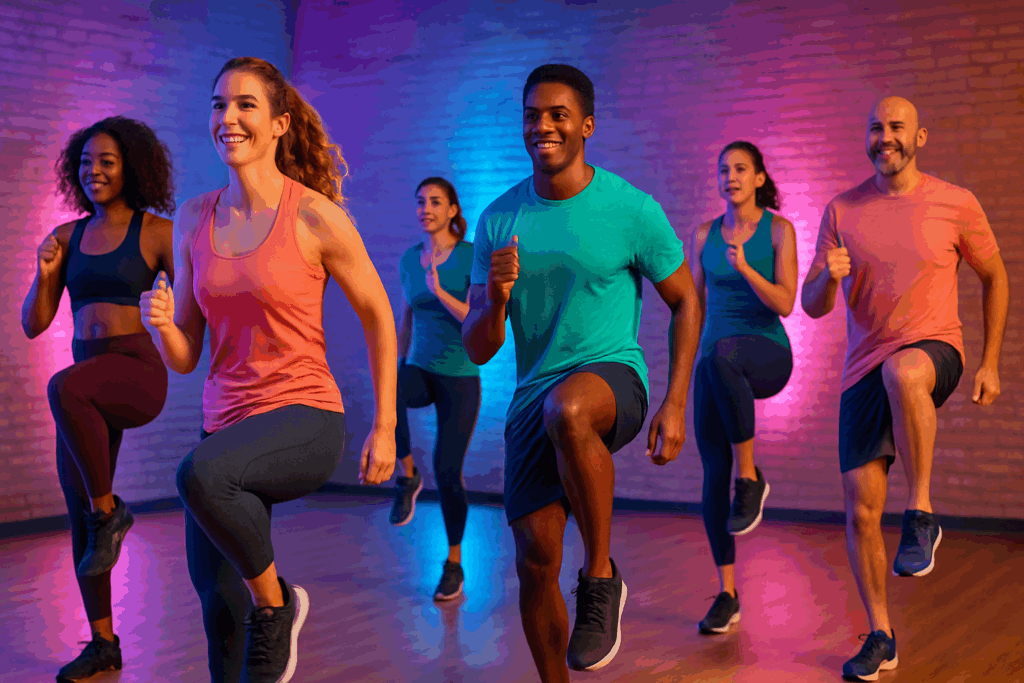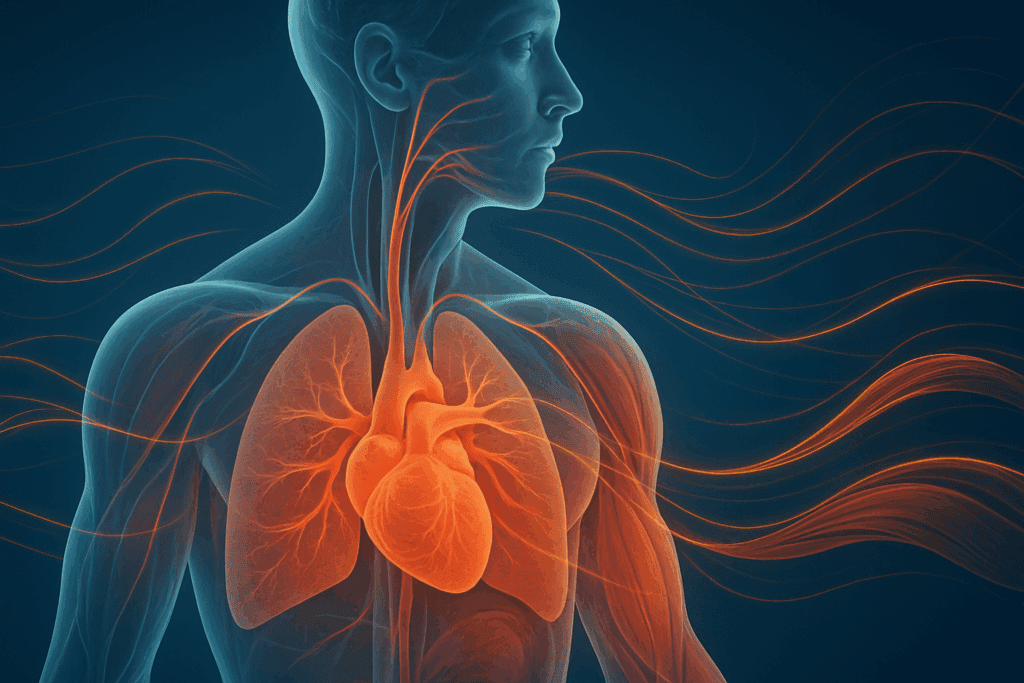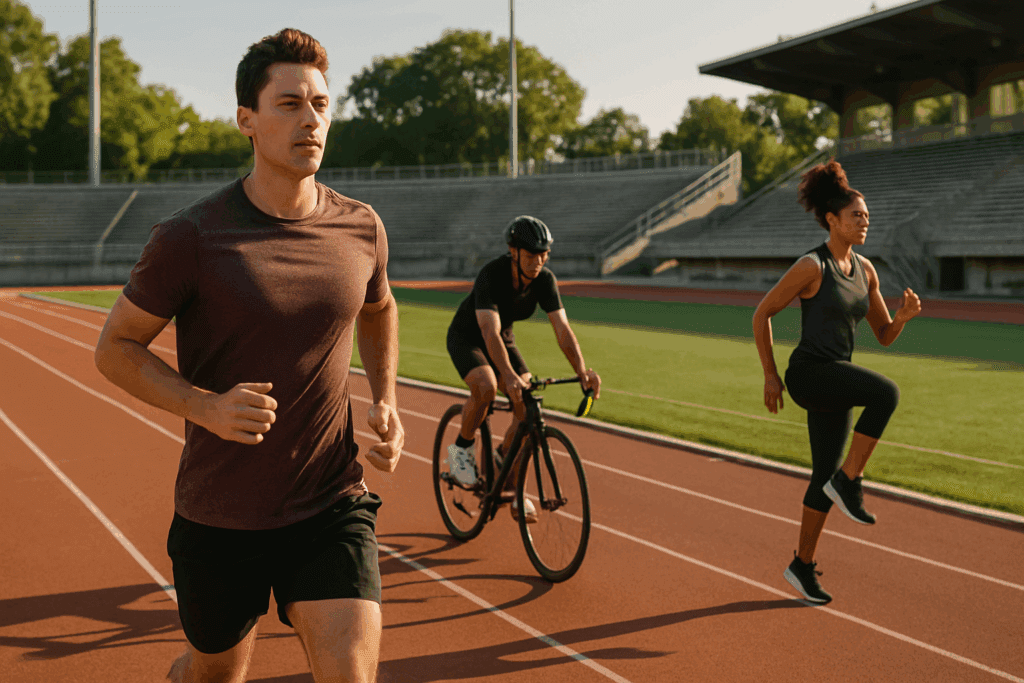Understanding the Foundation: What Is Considered Aerobic Exercise?
To appreciate the profound impact of aerobic activity on endurance and performance, one must first understand what is considered aerobic exercise. At its core, aerobic exercise—often referred to as “cardio”—is any physical activity that increases the heart rate and respiration while using large muscle groups repetitively and rhythmically. The term “aerobic” itself translates to “with oxygen,” which emphasizes the body’s reliance on oxygen to generate energy during sustained physical exertion. This distinguishes it from anaerobic activity, which relies more heavily on energy sources stored in the muscles and is performed in short bursts.
A defining characteristic of aerobic exercise is its reliance on oxygen over an extended duration. This means with oxygen exercise examples include running and swimming, cycling, rowing, and even brisk walking. These are just a few common aerobic exercise examples that illustrate how varied and accessible this form of training can be. What is an aerobics session, if not a structured combination of these movements performed rhythmically to music or a routine? From dance-based classes to treadmills in your aerobic exercise gym, the breadth of possibilities is wide. Aerobic training sessions may range from 20 to 60 minutes or more, depending on one’s fitness level and goals. Regardless of the format, the goal remains consistent: to challenge the cardiovascular system in a sustainable, oxygen-fueled manner.
You may also like: How to Increase Stamina and Endurance Naturally: Smart Training Tips and Nutrition Habits That Support Cardiovascular Fitness

The Science Behind Aerobic Exercise: Why It’s Called “With Oxygen”
The aerobic exercise definition hinges upon the body’s metabolic process that uses oxygen to convert carbohydrates, fats, and, to a lesser extent, proteins into usable energy. This process occurs in the mitochondria—the energy factories of our cells—making aerobic exercise an efficient, long-duration strategy for fueling physical activity. As such, the body’s capacity to deliver oxygen to the muscles and efficiently use it is a critical indicator of aerobic fitness.
When you engage in aerobic movements examples such as swimming laps or jogging outdoors, your heart, lungs, and circulatory system collaborate to sustain performance. This collaboration not only improves oxygen uptake (known as VO2 max) but also enhances endurance capacity and overall cardiovascular health. One aerobic exercise sample might involve moderate-intensity cycling for 45 minutes, during which the heart and lungs work in tandem to meet increased oxygen demands. Over time, this stimulates physiological adaptations—stronger heart muscles, increased capillary density, and greater mitochondrial efficiency—that make each subsequent workout easier and more effective.
Understanding what is aerobic training from a physiological standpoint enables us to appreciate how it differs from strength or high-intensity training. It’s not just about breaking a sweat; it’s about sustained, rhythmic exertion that trains your body to endure. This training becomes especially relevant for athletes seeking to optimize stamina, improve energy utilization, and achieve peak performance.

Types of Aerobic Exercise and Their Unique Benefits
The landscape of aerobic activity exercises is rich with diversity. Whether performed indoors or outside, in groups or solo, aerobic workouts cater to a wide spectrum of preferences, physical conditions, and training goals. One of the most common questions beginners ask is: which of the following is an example of aerobic exercise? The answer often includes running, swimming, cycling, or even dance-based aerobics workout at home. These are classic aerobic examples, but they represent only a portion of the full picture.
The best aerobics routines often incorporate different types of aerobic exercise to avoid monotony and keep the body challenged. Low-impact activities such as elliptical training or brisk walking provide aerobic activity options for those with joint concerns. On the other hand, high-impact workouts like running or jump rope routines push cardiovascular limits while also building bone density. Understanding the differences in aerobic training types allows individuals to tailor their programs effectively. For those just starting, light aerobic exercise such as gentle indoor cycling or water aerobics can offer an accessible entry point into the world of cardio fitness.
As variety is key, incorporating different aerobic exercise examples such as hiking, dancing, or even rowing machines at the gym ensures a holistic challenge to the cardiovascular system. Choosing what is considered aerobic exercise based on individual preference and physical condition is crucial for long-term adherence and success. A thoughtfully curated list of aerobic exercise options empowers people to stay consistent while gradually progressing in intensity and duration.

Integrating Aerobic Training for Endurance Enhancement
To boost endurance naturally, integrating aerobic training into a structured fitness routine is essential. Athletes and everyday fitness enthusiasts alike can benefit from understanding how aerobic activity exercises contribute to stamina. By performing steady-state cardio or interval-style aerobic exercise workouts, one can enhance the body’s ability to sustain prolonged effort without fatigue.
Aerobic training enhances mitochondrial density, which supports more efficient energy production during extended bouts of physical activity. In sports such as soccer, basketball, and long-distance running, aerobic conditioning ensures that players maintain high levels of performance well into the later stages of competition. What is aerobic training doing at a deeper level? It conditions the cardiovascular system, strengthens the lungs, and improves circulation, allowing oxygen and nutrients to be delivered more efficiently to working muscles.
Athletes often rotate through various types of aerobic training to match seasonal goals. During the off-season, long-distance steady-state workouts lay the foundation for cardiovascular efficiency. As competition nears, incorporating interval-based routines, such as a cardio aerobics exercise video series or spin classes, can add intensity and improve VO2 max. Those aiming to build endurance for performance enhancement must remain consistent while gradually increasing the complexity and duration of their aerobic exercise gym sessions. This deliberate progression prevents injury and supports continuous improvement.

Aerobics at Home: Accessible Training That Yields Real Results
The modern fitness landscape has made it easier than ever to engage in aerobics workout at home. From online platforms offering streaming classes to fitness apps delivering customizable plans, home-based aerobic training is convenient and effective. For those wondering what are some aerobic exercises they can perform at home, options include high-knee marches, dancing, step aerobics, jump rope, and even shadow boxing. All of these qualify as great aerobic workouts that require minimal equipment but deliver substantial benefits.
This flexibility is ideal for individuals with busy schedules or limited access to fitness facilities. It enables consistent aerobic training even during travel or inclement weather. One of the most common misconceptions is that effective aerobic exercise requires fancy gym equipment. In reality, a high-quality aerobic exercise sample may consist of bodyweight routines that incorporate aerobic movements examples like jumping jacks or burpees. With the right structure and intensity, these can elevate the heart rate and keep it in the target zone for cardiovascular conditioning.
Moreover, the rise of virtual training programs and cardio aerobics exercise video libraries allows individuals to follow along with expert guidance while maintaining the comfort and privacy of their home. Whether through dance cardio, HIIT-inspired sessions, or low-impact chair workouts for older adults, the best aerobic exercise at home is the one that aligns with your fitness level and keeps you motivated. With consistency and creativity, at-home workouts can rival the effectiveness of any gym-based program.

Maximizing Performance Through Progressive Aerobic Conditioning
Aerobic conditioning is not a one-size-fits-all approach. It requires a strategic and progressive buildup to optimize performance and avoid plateauing. Athletes, in particular, benefit from a well-periodized approach that varies intensity and volume to match their sport-specific needs. This method aligns with how professional trainers define and structure types of aerobic training throughout a performance cycle.
In the early stages of a training program, emphasis is typically placed on building an aerobic base. This phase consists of low to moderate intensity aerobic activity exercises sustained for extended durations. For example, long-distance running or cycling is often utilized to build foundational stamina. As the body adapts, the program may progress to include tempo runs, interval sessions, or fartlek training—each representing a unique aerobic exercise workout that stresses the cardiovascular system in different ways.
One of the most powerful strategies in aerobic training is periodization, where exercise intensity is adjusted over time to optimize results. Integrating recovery phases, active rest days with light aerobic exercise, and deload weeks helps mitigate overtraining while promoting long-term gains. In this structure, knowing what is considered aerobic exercise and selecting from a list of aerobic exercise options becomes essential to maintaining a dynamic routine.
Whether training for a marathon or simply trying to enhance daily energy levels, progressive aerobic development is a cornerstone of effective performance enhancement. Consistency, paired with gradual overload and intelligent variation, allows athletes and fitness enthusiasts to tap into their full endurance potential.

The Role of Aerobic Training in Mental and Metabolic Health
While much of the conversation around aerobic exercise revolves around physical endurance, its benefits extend far beyond the muscular and cardiovascular systems. Emerging research highlights the impact of aerobic activity on mental and metabolic health. Engaging in good aerobic workouts regularly can support mood regulation, cognitive function, and even neuroplasticity—the brain’s ability to adapt and form new neural connections.
The mechanism behind these benefits lies in the hormonal and biochemical changes induced by sustained aerobic training. Activities such as running and cycling stimulate the release of endorphins and serotonin, natural mood enhancers that contribute to emotional well-being. Furthermore, aerobic exercise examples such as dance and rhythmic movement can serve as stress relief, grounding individuals through repetition and physical expression.
Metabolically, aerobic training plays a key role in improving insulin sensitivity, regulating blood sugar levels, and managing weight. For individuals with metabolic syndrome or prediabetes, adopting types of aerobics that can be performed consistently—like walking, swimming, or cycling—can be life-changing. These benefits illustrate that what is an aerobics session offers more than just a calorie burn; it provides a foundation for holistic well-being.
Even light aerobic exercise done regularly can yield measurable improvements in mood and cognition. This has profound implications for aging populations, students, and professionals managing high-stress environments. Aerobic training becomes not only a physical tool but also a mental and emotional anchor, making it indispensable for overall performance enhancement.
Frequently Asked Questions (FAQ): Aerobic Exercise and Endurance Training
1. What are the benefits of incorporating low-impact aerobic exercises for older adults or beginners?
Low-impact aerobic exercises offer a safe and effective entry point for individuals who are new to fitness or managing age-related physical limitations. These aerobic activity exercises place minimal stress on the joints while still elevating the heart rate to improve cardiovascular health. What is considered aerobic exercise in this context includes walking, stationary cycling, and aqua aerobics, all of which provide health benefits without high-impact movements. These forms of light aerobic exercise improve balance, coordination, and circulation while enhancing stamina over time. For older adults, the best aerobics options may also aid in reducing the risk of falls and maintaining functional independence, making them an essential part of a healthy aging strategy.
2. Can aerobic exercise help with cognitive function and brain health?
Emerging research shows that aerobic exercise positively influences brain structure and function, particularly in areas related to memory and decision-making. During an aerobic exercise workout, the increased oxygen supply supports neurogenesis—the growth of new brain cells—and enhances connectivity in neural networks. Regular participation in aerobic movements examples such as brisk walking, swimming, or cycling has been linked to improved concentration, emotional regulation, and protection against age-related cognitive decline. What is aerobic training if not a catalyst for holistic well-being, including mental resilience? Whether through aerobic exercise at home or a structured aerobic exercise gym program, prioritizing cardio-based movement can contribute significantly to long-term brain health.
3. How do different types of aerobic exercise support sport-specific performance goals?
Different types of aerobic training offer unique adaptations that align with specific athletic needs. For endurance athletes like marathoners, longer sessions of steady-state aerobic exercise are crucial for building stamina and increasing aerobic threshold. On the other hand, sports requiring bursts of speed and recovery—like soccer or basketball—benefit from interval-based aerobic activity exercises that improve recovery and lactate clearance. One aerobic exercise sample for these athletes might involve repeated 400-meter sprints with active recovery, combining elements of both aerobic and anaerobic conditioning. What is considered aerobic exercise in competitive sports often depends on the event’s energy demands, and tailoring training accordingly can elevate performance to elite levels.
4. Is there a psychological benefit to choosing group aerobics instead of solo workouts?
Yes, participating in group workouts—such as a community-based workout aerobics class or a live-streamed cardio aerobics exercise video—can foster social support, accountability, and enhanced motivation. Engaging in aerobics workout at home with a virtual group or joining a local class offers a shared sense of progress and belonging that often leads to higher adherence rates. Group dynamics introduce variety, camaraderie, and a fun atmosphere that helps reduce the monotony of repetitive training. Additionally, synchronized aerobic movements examples like step routines or dance cardio stimulate both the body and brain, contributing to improved mood and mental focus. The collective energy and encouragement found in group settings often enhance the effectiveness of good aerobic workouts.
5. What are some lesser-known examples of aerobic activity that can be integrated into daily routines?
Beyond traditional options like jogging or cycling, aerobic exercise examples can include lifestyle movements such as gardening, dancing, or hiking with a consistent pace. These activities, while often overlooked, meet the aerobic exercise definition by maintaining a moderate intensity level that supports oxygen-driven energy production. One might not initially associate yard work with what is aerobic training, but prolonged periods of raking leaves or shoveling snow can provide cardiovascular benefits. When choosing what are some aerobic exercises for daily integration, consider tasks that involve continuous movement and elevate the heart rate for at least 10 minutes. These real-world aerobic examples make fitness more accessible and sustainable for individuals with demanding schedules.
6. How can wearable fitness technology enhance the effectiveness of aerobic workouts?
Modern fitness trackers and smartwatches play a pivotal role in optimizing aerobic exercise workouts by providing real-time data on heart rate, pace, and calorie expenditure. These tools help users monitor whether they’re training within their aerobic zone, ensuring that the effort aligns with cardiovascular fitness goals. For example, while following a cardio aerobics exercise video, users can assess whether their heart rate remains in the optimal range for fat burning or endurance development. Tracking progress with technology also supports consistency and motivation, especially when setting goals related to completing a list of aerobic exercise routines or achieving personal records. In this way, wearable tech enhances both the precision and enjoyment of workout aerobics sessions.
7. What strategies can help prevent overuse injuries during aerobic training?
To avoid overuse injuries, it’s important to vary aerobic activity exercises and allow for adequate recovery. Alternating between high-impact and low-impact sessions—such as pairing running with swimming or using an elliptical machine—reduces repetitive strain on joints and soft tissues. Incorporating strength training can also enhance joint stability, while flexibility exercises reduce muscular imbalances caused by repetitive aerobic movements examples. Even within a structured aerobic exercise gym program, rest days and light aerobic exercise sessions are essential to promote healing and adaptation. Listening to one’s body, rotating types of aerobics, and ensuring proper form are all proactive steps toward injury prevention.
8. How does environmental setting affect the benefits of aerobic training?
The setting in which aerobic exercise is performed can significantly impact both physiological outcomes and psychological satisfaction. Outdoor environments—such as parks, trails, or beaches—offer fresh air, varied terrain, and natural scenery that may enhance mood and motivation. When comparing aerobic examples performed indoors on treadmills versus those done in natural settings, the latter often lead to higher perceived enjoyment and reduced stress levels. Weather, air quality, and safety considerations are important, however, and sometimes the best aerobic exercise at home or in a gym may offer better consistency and environmental control. The versatility of aerobic activity ensures that training can be adapted to fit any location without sacrificing effectiveness.
9. What role does nutrition play in supporting effective aerobic training?
Nutrition is a foundational element of successful aerobic training, influencing energy availability, endurance capacity, and recovery. Carbohydrates are especially important, as they provide the primary fuel source during sustained aerobic exercise. Meals rich in complex carbohydrates, consumed before a workout aerobics session, help delay fatigue and support longer durations of effort. Post-workout nutrition—especially when completing a longer aerobic exercise sample like a 90-minute cycling session—should include both protein and carbs to facilitate muscle repair and glycogen replenishment. Hydration, electrolyte balance, and micronutrient intake further contribute to the body’s ability to perform and recover from all types of aerobic exercise.
10. What innovations are emerging in the field of aerobic exercise programming?
The future of aerobic training is being shaped by personalized programs driven by artificial intelligence, virtual reality, and biomechanical analysis. Some of the best aerobics platforms now use adaptive algorithms that adjust workout difficulty based on biometric feedback and performance trends. Virtual reality systems offer immersive experiences that simulate running trails, cycling tours, or group aerobics at home, adding an element of gamification that keeps users engaged. There is also increasing interest in blending mind-body practices with aerobic exercise—such as rhythmic breathing techniques or mindfulness cues within aerobic movements—to enhance focus and reduce anxiety. As interest in holistic wellness grows, future aerobic exercise examples may incorporate mental, emotional, and social metrics alongside traditional cardiovascular benchmarks.
Conclusion: Embracing Aerobic Training as a Path to Sustainable Performance and Wellness
Understanding what is considered aerobic exercise is the first step toward unlocking its full potential for both endurance and overall health. From its oxygen-dependent mechanisms to its wide-ranging physical and psychological benefits, aerobic exercise offers a powerful means of enhancing stamina naturally. The list of aerobic exercise options is extensive and adaptable, allowing individuals of all fitness levels to find routines that suit their preferences and goals.
Whether you choose a structured aerobic exercise gym routine, explore great aerobic workouts at home, or experiment with various types of aerobic exercise outdoors, the key is consistency and progression. An effective aerobic training program isn’t just about burning calories—it’s about building resilience, improving cardiovascular efficiency, and fostering a sense of vitality that permeates all areas of life. By integrating examples such as dance, running, and swimming, and learning what are some aerobic exercises that work best for your body, you create a sustainable fitness practice.
The power of means with oxygen exercise examples include running and swimming, yes—but it also includes the empowered, informed choices that individuals make when they commit to long-term wellness. Aerobic activity is a cornerstone of physical training, mental health, and performance longevity. For anyone seeking to enhance endurance, gain mental clarity, or simply feel more energized in daily life, embracing aerobic training is not just a recommendation—it’s a game-changer.
Was this article helpful? Don’t let it stop with you. Share it right now with someone who needs to see it—whether it’s a friend, a colleague, or your whole network. And if staying ahead on this topic matters to you, subscribe to this publication for the most up-to-date information. You’ll get the latest insights delivered straight to you—no searching, no missing out.

